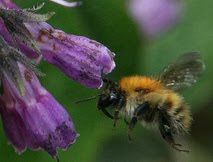 ( Courtesy of WikiMedia Commons )
( Courtesy of WikiMedia Commons )The skull is the protective case for the brain and the organs of sight, taste, hearing, balance and smell. It has two main parts: the cranium or brain case and the facial bones. It is divisible into two parts :
the Cranium consisting of 8 bones which lodge and protect the brain. There names are:
Frontal, Parietal (2), Occipital, Temporals (2), Sphenoidal, Ethmoidal
and the Facial Bones which number 14:
Nasal (2), Maxillae (2) , Lacrimal (2) , Zygomatic (2), Palatines (2), Inferior Nasal Conchae (2), Vomer, and Mandible
For a total of 22 bones making up the structure of the skull.
The base of the skull is stronger and thicker than the top and sides, and has many openings for blood vessels, nerves and tubes to pass through. The facial bones enclose the front of the brain and form the openings for the eyes and nasal and oral cavities. The mandible is the only movable bone of the skull.
When you inhale air, it passes through a series of chambers and passageways that conditions, cleans and warm it before it reaches your lungs. The air first enters your body through two nostrils, which open into two large chambers, the nasal cavity. These cavities also contribute to resonance and timber of your voice. Explains why your voice sounds different when you are congested, doesn’t it ;^)
 (courtesy of WikiMedia Commons)
(courtesy of WikiMedia Commons)The sinus are a series of connected cavities in your skull. They are: The maxillary sinuses located in the cheekbones (#4), the frontal sinuses in the low center of the forehead,(#1) the ethmoid sinus which is between the eyes at the nasal bridge (#2), and the sphenoid sinuses,(#4) in bones behind the nasal cavity. As a group, these pairs of sinus cavities are known as the paranasal sinuses and each is named for the facial bones in which they appear. They are lined with a soft, pink mucosa, a thin layer of mucus.
Allergies, colds, pollutants and other irritants can cause problems with these sinuses and nasal cavity. The mucous production can become accelerated in an attempt to “wash out” these irritants from the body. The whole works can become inflamed, swell up thus blocking the mucous flow causing infection and impaction making the person subjected to all this headachy, congested, sneezy, runny nose, watery eyed and have plugged ears, amongst other things.
The ears, nose and throat are all connected by the Eustasthian tubes. That is why if you are having trouble with your sinuses, generally you might also have trouble with your ears and throat also! To help unplug by dissolving and removing this excess mucus, catarrh and phlegm, anti – catarrhal herbs include coltsfoot, fennel, hyssop, linden, sage, elderflower, cinnamon, and mullein.
For seasonal allergy problems, one of the best things is to use local raw honey year round. A tablespoon of organic apple cider and honey in a cup of warm water before going outside during the allergy season, works to block our bodies histamine reaction and helps with inflammation also. Nettles is excellent for this seasonal reaction. Eaten as a food, tincture of tea, an easy way to help ourselves. Essential oils that might help are Hyssop, Thyme, Cypress, and Peppermint.
Whether your sinus problems are due to allergies, a cold or other irritant, you might consider a simple tea blended from antihistamine, anti inflammatory herbs such as nettle, yarrow, elderflower, peppermint, hyssop and thyme when faced with a sinus inflammation or infection. A neti pot is useful during this time. Horseradish and wasabi are sure to unclog your sinuses and get things moving if you are plugged up. Fire cider is good way to support your immune system and counteract your bodies response to soothe things out.
Essential oils diffused that might be helpful include Eucalyptus, Lavender, Melissa, Chamomile, Hyssop, Peppermint, Sage or Thyme in a pot of boiling water or a vaporizor. Humidifying the air is helpful in itself. Just simmering some elecampane root, peppermint leaves or mullein leaves in a pot of water and inhaling the steam can help with congestion.
 ( courtesy of WikiMedia Commons)
( courtesy of WikiMedia Commons)The outer ear is made up of the pinna, the ear canal and the surface of the ear drum. Ear wax is produced in the outer portion of the ear canal.
The middle ear is an air-filled cavity behind the ear drum, )tympanic membrane) and includes the three ear bones, the ossicles which are the malleus (or hammer), the incus (or anvil), and the stapes (or stirrup). The opening of the Eustanchian tube is also within the middle ear.
The inner ear includes both the organs of hearing, the cochlea and the labyrinth or vestibular apparatus, which is attuned to the effects of both gravity and motion. The other parts of the inner ear consists of three semicircular canals and the vestibule. The inner ear is protected by the hardest bone in our bodies and this bone has fluid-filled hollows. The chochlea has three fluid filled spaces also. The scala tympani, the scala vestibuli and the scala media. the eighth cranial nerve comes from the brain stem to the inner ear. Sound strikes the ear drum, this movement transfers to the stapes, whose footplate presses into one of its fluid-filled ducts through the window of the cochlea. The fluid inside this duct is moved and flows against receptor cells in the Organ of Corti. These stimulate the spiral ganglion which send the information to the auditory portion of the eighth cranial nerve to the brain. Fluid in these canals and hairs cells within help with our balance.
When we are congested and have “plugged ears” anti-catarrhal herbs can help with this problem also. ( I listed several of these earlier.)
For ear infections a few drops of warmed garlic and mullein infused oils are very helpful in otitis media, or middle ear infections. Ear infections are common in children due to their smaller Eustachian tubes. If there is a suspicion of perforation of the ear drum, massaging this oil behind the ear might be helpful. These oils will help break up and wash out wax build up too.
External otis, or ear canal irritation happens sometimes to swimmers, especially. Prevention by making sure the ears are good and dry after swimming is important. Bend your head to the side and cup your hand against it and press creating a vacuum to help pull out excess water.
David Hoffman recommends for painful earache, Pennywort juice. Crush the leaves and sieve, collecting the juice. A couple of warmed juice drops placed in the affected ear with a cotton ball plug might be helpful. He also recommends Lobelia tincture the same way. Or if none of these are available , a couple drops of warmed infusion of Chamomile, Yarrow or Hyssop.
Tinnitus is another condition which can affect the ears. Likened to having the sound of crickets constantly playing in your head. Sometimes caused by exposure to too much industrial noises and others times by catarrhal congestion. Hoffman recommends Golden Seal and Black Cohosh for either cause taken as a tea or capsule over time.
Whether it is your sinuses, ears or head that aches with a cold or sinus infection, a lavender fomentation might be helpful to relieve the pain. Put some cold water in a bowl and add some drops of Lavender Essential Oil. Soak a cloth in the liquid, wring it out and place on the painful area. When it warms up, repeat. The herbal constituents permeate tissue. Placed on the back of the neck these herbal actions go right into your central nervous system to calm down the inflammation associated with a sinus headache. Can also be used against your ears, or facial sinuses for relief.
 ( courtesy of Glaucoma Research Foundation)
( courtesy of Glaucoma Research Foundation)The eye is protected by a tough, white covering called the Sclera. Part of the Sclera can be seen at the front of the eye when you look at it. A clear, delicate membrane called the conjunctiva covers it. The cornea is at the front of the eye. It is the clear part of the eye’s protective cover. The iris is the colored part of the eye. It contracts and expands so your pupil can let in the right amount of light. The pupil directs the light to your lens which focuses the light on the membrane at the back of your eye, the retina. Nerve fibers in the retina carry images via the optic nerve to your brain. The front part of the eye is filled with intraocular fluid or aqueous humor, which is a clear fluid made by the Ciliary body. The fluid flows out through the pupil and is then absorbed through the bloodsteam through the eyes drainage system. The drainage system is a series of canals around the outer edges of the iris. Tears are produced by glands, and are release through tear ducts outside the eye and moisten the outer surface of the eyeball. This keeps the eyes moist and washes away most debris.
Glaucoma is a condition where the drainage system of the eye can become clogged, the intraocular fluid can not drain and damage happens to the optic nerve and vision loss can occur. Unfortunately, this can also be an inherited condition.
Other conditions that can affect the eyes include conjuctivitis, an inflammation of the conjunctiva. This can occur as a side affect of a cold or hayfever, or environmental pollutants. Taking the aforementioned herbs for these conditions might help as well as using an Eyebright, Euphrasia officinalis,both internally, as it is a good decongestant and externally as a beneficial eyewash. You can also apply a Eyebright tea soaked cloth to your closed eyes for relief. Calendula might also be used the same way and for the same reasons.
Lots of accidents due to foreign objects hitting or getting blown into the eyes can occur also. For those of you with Facebook accounts, you might find this video by Sevensong Sevensong of interest on using an eye cup.
There are many other conditions and accidents that can happen to our skull and it’s parts, but these are just a few I chose to highlight for part of my Springfield Sanctuary Apprenticeship program, October/ November Task list assignments.
Herbal and Honey Hugs to all Who visit Comfrey Cottages xx













2 comments:
Wow, I've learned lots just by skimming, will come back to study more later : ) thanks
you are so welcome :)
Post a Comment